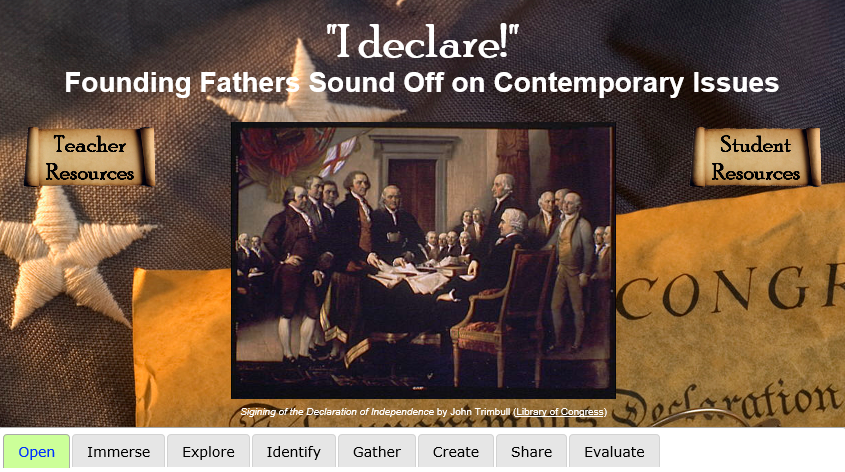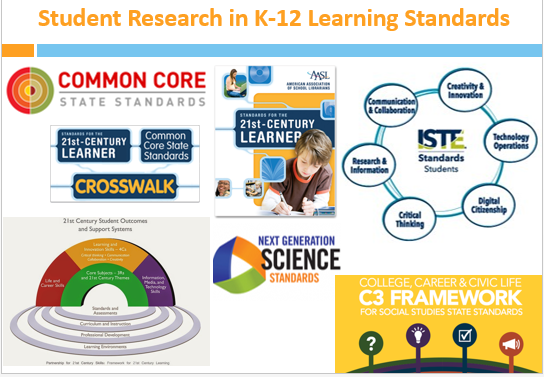

Hello fellow Guided Inquiry fans!
I’m Kelly Ray, a Library Media Resource teacher with the Office of Digital Learning at the Baltimore County Public Schools (BCPS). I’m so excited to provide a district-level perspective, by sharing how Guided Inquiry is transforming student research and inquiry in our large public school system!
BCPS is the 25th largest public school district in the U.S. and 3rd largest in Maryland, with 175 schools, programs, and centers. At the district’s annual Summer Curriculum Workshops, our Library Media team collaborates with content curriculum writers to design standards-aligned research tasks. Since 1998, we have designed Online Research Models (ORMs) which structure the research process, integrating information literacy skills development and content learning for students. You can see our current inventory of Online Research Models (for extended, in-depth research, labeled ORM) and Slam Dunk research models (for brief, focused research, labeled Slam Dunk) here. *Please excuse any broken links in these models; our team will be updating links over the summer. For years our ORMs were structured according to our own process model, which was inspired in part by Dr. Kuhlthau’s ISP. Our original ORM steps were: Scenario, Task & Product, Assessments, Gather & Sort, Organize, and Conclusion. These steps evolved only slightly until 2012.
In July 2012, I participated (along with our since retired Coordinator, Della Curtis) in the CISSL Summer Institute at Rutgers, where we were introduced to Guided Inquiry Design. At the end of the first day of the Institute, we knew that GID would be transformative for our BCPS ORMs. That very evening, we worked well past midnight (yes, really!) to begin designing a new ORM using GID. The result was An American Student in China, a research model for high school students participating in our BCPS Chinese Cultural Exchange Program. Each year, a group of students spends part of the summer visiting and attending school in China. As part of the program, students must research a topic of their choice related to that experience. We had been asked by our Office of World Languages staff to develop a new ORM for this research task. Part of the reason for their request was that students had been producing low-level “topical” reports on landmarks they had visited, like the Great Wall of China or the Terracotta Warriors— reports with little personal significance or reflection, about topics they could have researched without actually visiting China.
We designed An American Student in China by incorporating the 8 phases of GID with our existing ORM steps. Since this GID-aligned ORM was first launched for the 2012-13 school year, students have been better able to identify a research focus and question that is personally meaningful and relevant to their own interests and experience in China. Office of World Languages staff has reported that students’ projects have been more varied and unique, including topics like Chinese family life, traditions, education, music, and pop culture. *Unfortunately I do not have examples of student research products to post here now, but I will try to get access to some of these to share later.
After creating that first ORM at the CISSL Institute in 2012, we re-formatted many of our existing Online Research Models to incorporate GID. We’ve paid deliberate attention to Third Space—something that our previous ORMs were lacking. Some of our early ORMs included Scenarios with introductions like, “Congratulations! You’ve been selected as a member of the Board of Directors of the Smithsonian!” (SERIOUSLY? How many middle school students would really relish that prospect?) Since adopting GID, our ORMs endeavor to engage students in the Open phase by making more relevant real-world connections to their lives. In addition, our former research Scenarios typically included only one link to an article or video for building background knowledge and connecting to content. Our ORMs now provide more resources and time for these important activities in the Immerse phase of the process. We’ve worked to provide more resources and choices for students to “look around,” “dip in,” and “explore interesting ideas” in the Explore phase, BEFORE they Identify an inquiry focus/question and move forward into the Gather phase. We’re encouraging our content curriculum collaborators to allow for greater student choice in how they’ll Create to communicate and Share their knowledge with others. And we’ve built into our ORMs the crucial opportunity for student reflection and self-evaluation during the Evaluate phase.
 Since 2013 we have dispensed with our original ORM steps, and have been using the 8 GID phases exclusively to design research tasks for all grade levels and content areas. See these examples: Act Now! Supplies Limited (Grade 5 Library Media/Environmental Science); Power of the Pen: Writers as Agents of Social Change (Grade 6 GT English Language Arts) and Epidemic Experts (Grade 7 English Language Arts); and I Declare! Founding Fathers Sound Off on Contemporary Issues (Grade 11 English Language Arts). These Online Research Models are included in content curriculum guides, where teachers are encouraged to collaborate with their school’s library media specialist to integrate information literacy skills instruction at identified “zones of intervention.”
Since 2013 we have dispensed with our original ORM steps, and have been using the 8 GID phases exclusively to design research tasks for all grade levels and content areas. See these examples: Act Now! Supplies Limited (Grade 5 Library Media/Environmental Science); Power of the Pen: Writers as Agents of Social Change (Grade 6 GT English Language Arts) and Epidemic Experts (Grade 7 English Language Arts); and I Declare! Founding Fathers Sound Off on Contemporary Issues (Grade 11 English Language Arts). These Online Research Models are included in content curriculum guides, where teachers are encouraged to collaborate with their school’s library media specialist to integrate information literacy skills instruction at identified “zones of intervention.”
Based on feedback from school librarians, teachers and students across the district, we know that Guided Inquiry Design has transformed the student research experience in BCPS to increase their engagement in the inquiry process, helping to facilitate their successful acquisition of skills aligned to the AASL Standards for the 21st Century Learner, the Framework for 21st Century Learning, ISTE Standards for Students, and Common Core State Standards … not to mention content standards like the NGSS and C3 Framework.

Stay tuned for my next post, where I will share some of our team’s professional development efforts and other resources we’ve developed to support the use of Guided Inquiry in school libraries and classrooms across our large district.